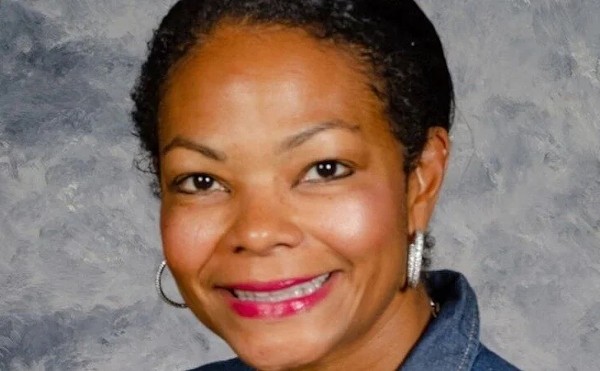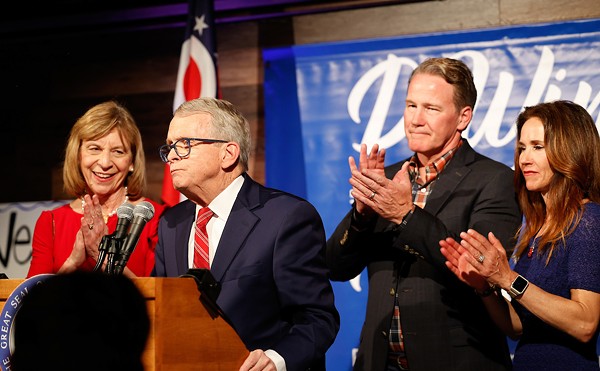George Randt didn't go into medicine for the money. His influence was Dr. Bob — Robert Ballard, MD, a neighbor and family friend in post-World War II Bay Village whom Randt calls a true family physician. "He made house calls. He'd come down and see us when we were little and bring that black bag with the medicinal smell. He'd sit on the edge of the bed, and you immediately felt better just having him be there," says Randt. "And at street parties he'd bring out the banjo."
Back then — and when Randt graduated from Case Western Reserve University Medical School in 1967 — doctors were not put out of business by the dealings of billion-dollar hospital systems. They weren't left to cobble together odd jobs and consider unemployment eligibility. Back then, such stories would have been passed off as tall tales, but not so anymore.
After 26 years of operating a successful private practice, Randt sought employment with a physicians' group owned by University Hospitals three years ago. The economics of medicine, lower pay from insurers, and competition from health-system-run physician groups made it too difficult to remain independent.
Last year, Randt devoted an average of 26.64 minutes to each patient who walked through his office, but that wasn't good enough. From what can be gleaned from the "metrics" — that endearing measure of corporate performance — Randt's employer had been hoping for something closer to 23.8 minutes per visit, preferably better.
"It takes that long to get some older patients into the exam room, and when they do get there they need extra time because they might be a little confused," says Randt, 69. "The real tragedy is for the patients." It's a statement he repeats often, and one that causes his eyes to well up every time. "I always put the patients first."
Randt and his practice partner were fired in April because of lack of productivity, he was told. (Randt's former partner asked not to be identified for this story.) He was also told that the local economy — the comfortably middle-class suburbs of Cleveland's West Side — could not support the existing number of primary care physicians.
"I'm devastated. I really do not know where we are going to go," says Bay Village resident Bonny James. "I don't want to go somewhere where the doctor has their hand on the doorknob and you're still sitting on the table saying, 'Yes, but...'"
James, a former nurse, and her husband, Leland, have been patients of Randt's for 24 years. "He was the kind of doctor you could call that day and he'd get you in," says Bonny. "Always."
When Randt decided to pursue the path of Dr. Bob, he specifically chose internal medicine — one of several main branches of study chosen by "regular" physicians — because he wanted to follow patients throughout the course of their lives.
"I was fascinated by the Sherlock Holmes, investigative aspect of diagnostics," Randt says. "I wanted to treat the whole patient." With an additional focus on preventive medicine and wellness, Randt provided his patients with a "medical home," a term bandied about in health-care reform discussions as if it's a new concept developed to save the day by keeping costs down and quality of care up.
But it was Randt's ability to achieve both that appears to have led to his undoing. "If he only averaged 13 patients a day, he was doing a good job at preventive medicine and driving down costs by encouraging patients to have a healthy lifestyle," says Leland James.
The problem was, keeping quality of care up and holding costs down didn't make anybody much money — including Randt, but he didn't mind so much. In April, after three years of Randt in its employ, the Cuyahoga Physician Network — a for-profit physicians' group subsidiary of nonprofit St. Vincent Charity Hospital — decided Randt was too expensive. He and his partner were met in their office by St. John's Medical Center CEO Cliff Coker and Cuyahoga Physician Network CEO Mark Weidt and given 30 days notice. After April 30, they would not be able to see their patients in those offices.
"His patients were too healthy. I think he was fired because he wasn't prescribing unnecessary tests or having people come in for unnecessary office visits. He was highly principled," says Leland James. "I think his termination is leverage to get other physicians to schedule unnecessary visits."
At the outset of Randt's career, there were no such things as physicians' organizations owned by monolithic health systems. After his residency, Randt headed the Navy's female medicine division, then moved on to a solo primary care practice in Clearwater, Florida. With a passion for long-distance running, he became active in the burgeoning boom of health and wellness. In 1980, he left private practice to create a wellness program at Toledo's Riverside Hospital.
He loved the job, but discovered he was not meant to be landlocked. In 1984, he returned to his native Bay Village with his wife at the time, a Rocky River native. He had been asked by St. John's to be the medical consultant for its new health promotion and wellness program. Randt maintained a part-time private practice, which he converted to full-time when the wellness program was cut in 1990. He originally rented space in the hospital, but things started getting rough. "I later moved to a lower-rent space next door," Randt says. His patients describe the old office as "humble."
"My focus was providing quality care to as large a group of patients as I could. You couldn't really open your doors to people who didn't have any money or who had Medicaid, because if you did, you'd be out of practice. So, as a business, you had to have a certain number of insured patients," he says.
In 1992, corporate competition arrived when St. John's started Westshore Primary Care, a for-profit physician group. "The goal was to develop a family practice group that could compete with the metastasizing Cleveland Clinic and University Hospitals," Randt says. "With managed care cutting insurance reimbursement and the Cleveland Clinic getting less international business, they wanted to reach out to the suburban areas, bypassing the cavity of poverty that surrounded them in the city of Cleveland. We could see what was happening. The outreach was coming, and we were at a disadvantage.
"The hospital was providing me with some financial aid at the time too, to keep my practice going." The arrangement would likely be illegal today. "I was a participant in what I would certainly consider as money-driven medicine," Randt says. Westshore Primary Care continued to be built up by St. John's. "They, again, had an advantage over somebody like myself, in solo practice."
Randt's enthusiasm for health and wellness was accompanied by a growing interest in the politics of medicine. He is now active with several organizations advocating universal health-care coverage. In a 1996 letter to the editor appearing in the Bay newspaper The Villager, he wrote of University Hospitals and Cleveland Clinic: "If these institutions were living by the principles on which they were founded, they would be setting up facilities in the inner city and underserved areas of Cleveland, Ashtabula County, or elsewhere where there was demonstrated need and not in Westlake, Independence, Willoughby, Solon, and in the case of the Cleveland Clinic Foundation, Fort Lauderdale, Vero Beach and Naples, Florida (hardly established pockets of poverty)."
Though Randt recognized the health systems for the big businesses they were, he couldn't have guessed that the insurgence of big medicine into his area would eventually put his practice out of business and his 1,000 patients and their insurance coverage up for grabs.
In 1999, the mega-medical outreach hit full force. University Hospitals Health System and the Sisters of Charity Health System formed a partnership; as a result, ownership and operation of St. John's, Westshore Primary Care, and St. Vincent Charity Hospital were split down the middle. In addition, Cuyahoga Physician Network was formed as part of the joint venture, thus bringing more competition to private practice doctors. Throughout the decade, the downtown giants had bought out private practices too, absorbing doctors and tens of thousands of their patients, helping to ensure that referrals — and money — stayed within the system.
Unbeknownst to Randt and most others, arrangements between University Hospitals and for-profit physician practices were proving to be less than squeaky clean. When a whistleblower lawsuit was filed in 2003, the U.S. Department of Justice and Health and Human Services' Office of the Inspector General investigated allegations that the health system engaged in a slew of illegal schemes giving financial incentives to doctors who then developed a penchant for referring their patients to University facilities.
Specifically, the lawsuit alleged that University Hospitals financed physician practice expenses, paid advances of at least $250,000 to recruit "loyal" physicians into practice plan arrangements, created phony "director" positions that paid annual stipends of about $150,000, and advanced millions of dollars to doctors under practice plan arrangements that required repayment. Though such a stipulation would have made the loans kosher, the suit claimed that no effort was made to collect the money. In addition, University Hospitals allegedly installed doctors — usually department heads — as owners of corporations organized as medical practices.
University paid the federal government $13.9 million to settle the suit in 2006 and admitted no wrongdoing. Most of the money went to repay Medicare for unnecessary or excessive claims made by physicians involved in the illegal arrangements. In the settlement, University agreed to a Corporate Integrity Agreement overseen by the federal government. That pact, effective until August 2011, is intended to put an end to illegal arrangements with physicians and mandates ongoing training for employees so they can avoid such situations and report them if they see them.
"The whole idea is like training wheels — to get them to set up compliance programs themselves," says Donald White, a spokesman for the Office of the Inspector General. His office makes site visits and audits University Hospitals billing reports. Several attorneys from White's office are assigned to monitor University and its billing. "It's a very close relationship," he says.
But federal oversight applies only to entities "wholly owned" by University Hospitals. By that measure, it does not include St. John's Medical Center, Westshore Primary Care, and the Cuyahoga Physician Network, all of which were part of the partnership between University Hospitals and the Sisters of Charity Health System, and operated under a separate corporation. White confirms that none of the jointly owned concerns were named in the lawsuit's allegations.
At the time the settlement was reached, Randt knew he had to look for employment. "I was drowning," he says. "There were some months when I had problems making any significant salary for myself because my overhead was so high and reimbursements were declining. And I was just getting tired of dealing with all the administrative aspects of my practice."
There were no openings at Westshore Primary Care, but he was offered a spot with Cuyahoga Physician Network in a joint practice with another primary care doctor he already knew and highly respected. He took it, bringing his office furnishings and his 1,000 patients with him. "When he chose to join a physicians' group, I wondered how he would fit in in a corporate world," says Scott Holtzman of Avon Lake, a former Motorola executive and a patient of Randt's for 13 years. "I was surprised to learn how old he is. If that were me at that age, I would have said screw it."
But things seemed to be going well for Randt. "What was different was that we could work at our own pace. If a patient took longer, they took longer," he says. "The appointment books were slotted for every 15 minutes, and some days I was scheduled every 15 minutes and some days I was less busy."
After his first year as a network employee, Randt, then 67, decided to cut back his hours. His 2008 and 2009 contracts with the network list his salary as $60,000 — not bad for a part-time gig, though not the pay typically associated with a physician.
But there was a way to earn more: According to Randt's contract, he would be paid a bonus amounting to 50 percent of any revenue he brought in above what it cost Cuyahoga Physician Network for his keep, including support staff, office space, malpractice insurance, office supplies, billing, and utilities. The other half of any income that put his practice in the black would be profit for the network. Because Randt earned nothing for patients sent to the hospital or other University Hospitals/Sisters of Charity facilities for tests, the only way he and Cuyahoga Physician Network could earn more was by seeing more patients.
Randt says he had no reason to believe he wasn't profitable. He saw patients in his office for 18 hours a week, spent 2 hours weekly on hospital visits, and estimates another 10 hours were spent reviewing charts and taking patients' phone calls. At the end of 2008, he received a bonus of $14,000, meaning he brought in $28,000 more than his expenses. His 2009 bonus sheet reports $8,424 for bringing in $16,848 more than he cost.
Although things were going well in the office, Randt was becoming increasingly concerned about the slant the quarterly physicians' staff meetings were taking. During the September 2009 staff meeting, he says, St. John's Chief Financial Officer Allen Tracy implied that the hospital's situation would greatly improve if each physician admitted just one more Medicare patient per month. "I was shocked," says Randt. "Everybody heard it."
Randt also took exception when, in more recent staff meetings, Tracy said that hospital admissions for patient observation — each worth $2,000 profit for the hospital — were increasing compared to admissions made for a definite purpose, which were worth three times as much. "It was more than a comment — it was a plea," says Randt. "Why do physicians need to know this? What does this have to do with patient care?"
"Al Tracy denies making the 'Medicare' statement," says Patrick Garmone, a spokesman for St. John's Medical Center. Garmone is unable to confirm dollar amounts associated with admissions and observations, but says, "Al Tracy provides this sort of information as a part of his routine financial update. For the most part, Al consistently provides financial updates to physicians at these meetings. Variations from one year to another almost always receive some commentary."
Randt is not alone in his concerns. A 2005 survey of 1,500 physician leaders nationwide showed that 54.6 percent describe themselves as "very concerned" about unethical business practices in health care. On a local note, the 2009 U.S. Government Accountability Office report shows that in the Cleveland hospital referral region, Medicare spending per beneficiary increased 20.6 percent between 2000 and 2008, and is listed as a "potentially overserved area," indicating a suspicion of excess Medicare claims. The average increase in other hospital referral regions was 13.7 percent.
As of January 1, 2010, the partnership between University Hospitals and the Sisters of Charity Health System was restructured. University is now divested of any ownership interest in Cuyahoga Physician Network and St. Vincent Charity Hospital, which sits in Ohio City but has gained 100 percent management control over Westlake's St. John Medical Center and its associated for-profit physicians group, Westshore Primary Care. Both of the latter are still jointly owned by University Hospitals and the Sisters.
Changes also came to Randt's 2009 metrics. After receiving his 30-day notice at the beginning of April, Randt inquired exactly how he had been "unproductive." After all, he had received a productivity bonus for 2009, and his contract had been renewed for 2010. In response, a completely different and infinitely more complicated set of numbers was produced — the kind of spreadsheet one glances at and just knows that there must be a line item for the box of paper clips lent to the colleague down the hall. Somehow, the $16,484 profit Randt showed in 2009 had been recalculated into a $62,069 loss.
When asked by Scene for an explanation for the discrepancy, Cuyahoga Physician Network Director of Marketing and Communications Wendy Hoke offered this statement: "CPN does subsidize physician practices, primarily for those in underserved areas. As far as Dr. Randt is concerned, CPN did not renew his contract. This is a private employment matter between a physician and employer, and as such, CPN will not provide any further comment."
Scene obtained a copy of Randt's employment contract, which commences January 1, 2010, for a period of one year. The contract is witnessed and signed by Cuyahoga Physician Network President Adnan Tahir, MD.
According to 2008 tax forms (the most recent year available), the University and Sisters partnership claimed an income loss of $5.8 million for Cuyahoga Physician Network, but accepted a $6 million payment from the group. It claimed a $3.2 million income loss for Westshore Primary Care, which paid the parent nonprofit $730,000 that year.
Shortly after the restructuring, University CEO Cliff Coker and Sisters of Charity President and CEO Sister Judith Karam, CSA, visited St. John's to explain the new agreement. Randt took the opportunity to ask them whether they had read the U.S. House of Representatives' proposal for a single-payer, public, universal health-care system, and if so, what they thought of it. Randt stood in the audience holding up a copy of the proposed legislation. The demise of private insurance would likely take a big bite out of hospitals' profits. In a gathering of physicians such as this, Randt's question may have been viewed as rabble-rousing.
"I'm convinced they did this because he is very politically active," says Kevin Coleman of North Olmsted, a patient of Randt's since 1992. "He was just concerned about the patients."
Dr. Bob — the man who inspired Randt's career in medicine so many years ago — had his banjo. Dr. Randt has Charley, an affable poodle who greets visitors in the driveway of his Bay Village home and did the same for years with patients in his office.
"He's not a real 'therapy' dog," Randt says, "but I used to take him to work with me when I had my own practice. Sometimes patients would stop in just to see Charley."
Once Randt started working for the network rather than for himself, Charley was no longer welcome at the office. Randt knows the feeling.
"I keep hoping he'll make house calls," says Coleman. "I was already dreading the day he would announce he was retiring. He saved my life. I lost 150 pounds because of him."
Like many of Randt's patients, Coleman has yet to choose a new physician.
"He's part of the family relationship, and that is irreplaceable," says Scott Holtzman. "I've been avoiding looking for someone because I had four months left on my prescriptions, but I'm going to probably have to find someone this month.
"I really like the private practice relationship, and given the health-care system today, that may be impossible to find."
When Randt was fired, his patients received a letter from St. John's listing four primary care physicians housed in the same building as Randt's former practice. All of the physicians listed are with Westshore Primary Care, which is managed by University Hospitals.
"They stole his patients!" says Bonny James. "I know I won't have anything to do with them or with St. John's. The only reason I went there was because of Dr. Randt." Coleman, too, says they will never get his business.
Randt describes the period during his 30-day notice as the worst in his life. He asked his staff to break the news to patients.
"My nurse said it was like attending the funeral of a close family friend every day for 30 days," Randt says.
Randt's home is scattered with remnants of a life devoted to medicine, and there is nowhere to escape reminders of his displacement. He donated the office equipment he will never use again to a hospital in Haiti, but there are patient education materials in his basement that he may never hand out, a bedroom that's lined with the bookshelves from his former office, and a dining room table stacked with medical advocacy information and a large etched-glass plaque thanking him for "25 years of dedicated service to St. John Westshore Hospital." If it were to break, he says, that would be OK.
Randt is not idle. He has leased a small space within another physician's office, from which he will continue to see the 15 to 30 patients he has been guiding through a weight-loss program. He's looking into doing some worker's compensation cases, maybe some medical coding, and he will continue with medical advocacy — perhaps putting a book of cartoons together to help people understand the broken health-care system. Then there are the students.
On the day Randt was interviewed in his home, he was reviewing a list of questions for a conference call organized by the American Medical Students Association, a talk with about 20 first-year medical students who had heard of his plight. To them, tales of house calls and black bags with that medicinal smell surely sound like the I walked 10 miles to school every day stories of a few generations ago.
"They have no idea of the struggle between insurance companies, health systems, pharmaceutical companies, and some physicians to get a piece of the $3 trillion spent on U.S. health care," Randt says.
What will happen to your patients? reads one of the questions. Where will they go for care?
"I don't know," Randt pens in his answer. "I lost my medical home too."
Maude L. Campbell is a freelance writer based in Parma Heights. Send feedback to [email protected].












